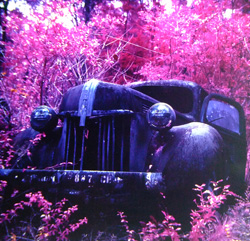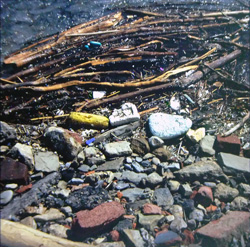I took this picture while on a bicycle trip with some friends. This is somewhere near Paris, Ontario. I don’t recall any of the details, camera used etc.
 The place: Addicks Dam ( & reservoir), Houston, about 3 miles from my house.
The place: Addicks Dam ( & reservoir), Houston, about 3 miles from my house.
Time: winter (notice trees)
Camera: Lopp-ified spud on tripod
I will say we can have some pretty cool sunsets here. This is a favorite place for hiking and fishing. Not sure if the fishing is any good. Since it is so close to our house we frequently go here. The Addicks Reservoir and Addicks Dam in conjunction with the Barker Reservoir prevent downstream flooding of Buffalo Bayou in the City of Houston. In addition to the Reservoir’s flood damage reduction mission, recreation and nature observation opportunities abound through the approximately 26,000 acres (105 km²) of land that makes up Addicks and Barker reservoirs.
 The place: Ohio Pass, Colorado
The place: Ohio Pass, Colorado
The time: September 2011
The weather: sunny
The camera: my trusty Lopp-ified spud!
We spent 17 days traveling in northern New Mexico, southeastern Utah and western Colorado. The tress were just beginning to turn and we saw some spectacular scenery. A far cry from the mesquite and pine trees here in Texas.
The place: Buffalo River National Park, Arkansas
The weather: very foggy and smoky.
Established in 1972, Buffalo National River flows freely for 135 miles and is one of the few remaining undammed rivers in the lower 48 states. Once you arrive, prepare to journey from running rapids to quiet pools while surrounded by massive bluffs as you cruise through the Ozark Mountains down to the White River.
It is a spectacular place. However, the area was in drought conditions when we took our trip. People who were canoeing had to portage their craft in many places. No motor craft is allowed on the river. Also, there were wildfires in New Mexico with the smoke traveling northward. Most of Arkansas was smoke shrouded that summer. We did not do a water trip and saw very few people in canoes. We had a good trip in spite of the weather conditions.
The Buffalo River is connected to the White River, which is connected to the Mississippi, and laps up on the beach of the Gulf states.
The image was shot with the Lopp-ofied spud.
 Many acronyms have been created for the letters in “Ford”. Most of them are unflattering. I’m a big Ford fan, so I’ve created a positive acronym for F.O.R.D. – “Forgotten Old Relic Discovered”. This old Ford is resting peacefully by the side of the road in Crawfordville, Florida. I bought some infrared filters for my TL-120 and shot a few rolls of Kodak Aerochrome on that trip. This is one of the results. This particular strain of Aerochrome can be (and was) processed in E6 chemistry. The film is rated at 400, and I took exposure readings through the TL-120’s meter. The metering lens also had an infrared filter on it. I much prefer to photograph old wrecks and decaying cars over restored vintage vehicles (even though I do appreciate restored vintage vehicles). It’s been said many times, but if only these old rust-buckets could talk!
Many acronyms have been created for the letters in “Ford”. Most of them are unflattering. I’m a big Ford fan, so I’ve created a positive acronym for F.O.R.D. – “Forgotten Old Relic Discovered”. This old Ford is resting peacefully by the side of the road in Crawfordville, Florida. I bought some infrared filters for my TL-120 and shot a few rolls of Kodak Aerochrome on that trip. This is one of the results. This particular strain of Aerochrome can be (and was) processed in E6 chemistry. The film is rated at 400, and I took exposure readings through the TL-120’s meter. The metering lens also had an infrared filter on it. I much prefer to photograph old wrecks and decaying cars over restored vintage vehicles (even though I do appreciate restored vintage vehicles). It’s been said many times, but if only these old rust-buckets could talk!
 I had my TL-120 down at Toronto’s waterfront and I was attracted by the myriad of shapes, textures and colours (or colors, if you happen to reside in The States) that were migrating towards the shoreline. I kept a tight composition with the intent of creating a sort of in-camera collage. I wanted to fill the frame with as many of the various and sundry debris as I could, illustrating the contrast between man-made and natural debris, without necessarily establishing an indication of their location. This was shot on Velvia 100 using the TL-120’s built-in meter.
I had my TL-120 down at Toronto’s waterfront and I was attracted by the myriad of shapes, textures and colours (or colors, if you happen to reside in The States) that were migrating towards the shoreline. I kept a tight composition with the intent of creating a sort of in-camera collage. I wanted to fill the frame with as many of the various and sundry debris as I could, illustrating the contrast between man-made and natural debris, without necessarily establishing an indication of their location. This was shot on Velvia 100 using the TL-120’s built-in meter.
We used to live in an old Victorian house in downtown Toronto. Access to the garages was via an alley, and that’s where I found the door in this photograph. The door served as an entrance to someone’s garden, and I was drawn to the textures of the weathered wood, tarnished metal, and peeling layers of paint. This might’ve been one of the first shots I took with my TL-120, or it might’ve been shot with my Sputnik – I’m not too sure. What I do know is that around this time my local lab stopped processing AGFA Scala, and I wanted to determine where I should send my Scala rolls in the future. I shot a few rolls and sent a couple to dr5, and a couple to Mainphoto. This is one of the shots from a Mainphoto roll. Washed out, not a lot of contrast. I think it has a vintage aged look to match the textures on the door. It would have been a very different shot had dr5 processed it. Not necessarily better, but different.
The Stars and Stripes and the US Seal are subtle signs of the US Consulate close to Quebec City’s Chateau Frontenac: http://en.wikipedia.org/wiki/Ch%C3%A2teau_Frontenac
The Consulate is witness to two centuries of friendship between the US and Canada following the war of 1812. I am playing in the early morning light with a mirror to juxtapose adjacent objects in new ways.
Original slide shot October 10th, 2011 with a tripod-mounted Sputnik using Provia 100P exposed at 1/25th at f22.
A large statue of Samuel de Champlain stands beside the Chateau Frontenac, in honour of his founding of Quebec City over 400 years ago:
http://en.wikipedia.org/wiki/Samuel_de_Champlain
In this early morning light I am playing with a mirror creating a picture within a picture, juxtaposing adjacent objects in new ways.
Original slide shot October 10th, 2011 with a tripod-mounted Sputnik using Provia 100P exposed at 1/25th at f22.
A historic building of old Quebec City is juxtaposed in the mirror onto the green fields surrounding the Citadelle, the city’s fortifications:
http://en.wikipedia.org/wiki/Citadelle_of_Quebec
In this series I have played with a mirror to juxtapose adjacent objects in new ways.
Original slide shot October 9th, 2011 with a tripod-mounted Sputnik using Provia 100P exposed at 1/25th at f20.